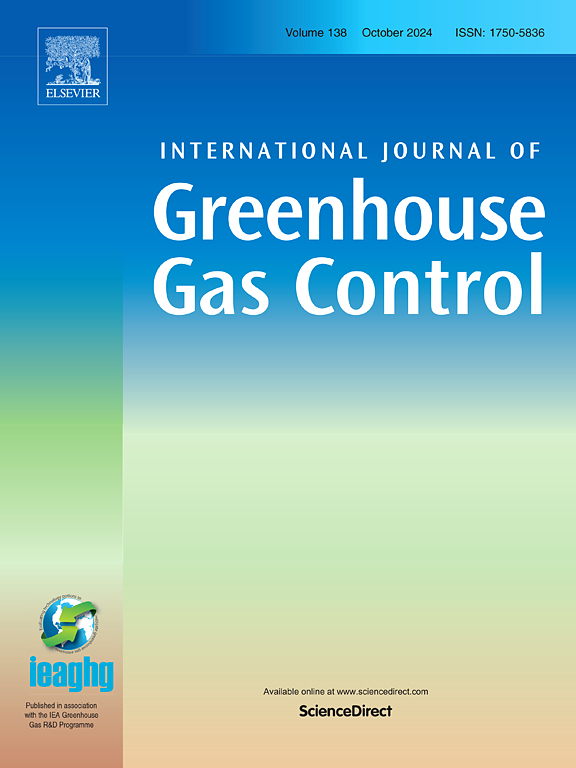Performance and mechanism investigation of CO2 capture by novel ternary MEA/tertiary amine/sulfolane biphasic solvents
IF 5.2
3区 工程技术
Q2 ENERGY & FUELS
International Journal of Greenhouse Gas Control
Pub Date : 2025-07-17
DOI:10.1016/j.ijggc.2025.104436
引用次数: 0
Abstract
Chemical-physical biphasic absorbents significantly reduce CO2 capture energy consumption. In this study, four tertiary amines were combined with monoethanolamine (MEA) and sulfolane to form ternary MEA/co-absorbent/sulfolane biphasic solutions for CO2 capture. The co-absorbents used were N-methyldiethanolamine (MDEA), 1-Dimethylamino-2-propanol (DMIPA), 3-(Dimethylamino)-1,2-propanediol (DMAP), and 3-Diethylamino-1,2-propanediol (DEAP). The dynamic phase separation behavior and properties were examined, the absorption/desorption characteristics were analyzed, and the phase separation absorption mechanism was explored through 13C Nuclear Magnetic Resonance (NMR) Spectroscopy. Results showed that all four ternary solvents performed excellently, achieving high CO2 loadings in the upper phases (3.09–3.41 mol/L), strong absorption and desorption efficiencies (over 92.5 % and 85 %, respectively), large cyclic loadings (above 2.67 mol/L), and reduced energy consumption (>45.81 % lower compared to 5 M MEA solution). The addition of tertiary amines improved the absorption performance of MEA/sulfolane solutions. Phase separation was influenced by amine solvent alkalinity and hydrophilicity, leading to the presence of sulfolane in both liquid phases and the selective distribution of MEA and tertiary amines. This research offers promising alternatives for efficient CO2 capture and provides theoretical guidance on liquid-liquid phase separation absorption mechanisms.
新型三元甲基丙烯酸甲酯/叔胺/环己烷双相溶剂捕集CO2的性能及机理研究
化学-物理双相吸收剂显著降低CO2捕获能量消耗。本研究将四种叔胺与单乙醇胺(MEA)和亚砜结合,形成MEA/共吸附剂/亚砜三元双相溶液,用于CO2捕集。共吸附剂有n -甲基二乙醇胺(MDEA)、1-二甲氨基-2-丙醇(DMIPA)、3-(二甲氨基)-1,2-丙二醇(DMAP)和3-二乙基氨基-1,2-丙二醇(DEAP)。考察了其动态相分离行为和性能,分析了吸附/解吸特性,并通过13C核磁共振(NMR)谱分析了相分离吸收机理。结果表明,四种三元溶剂均表现优异,具有较高的上相CO2负荷(3.09-3.41 mol/L)、较强的吸附和解吸效率(分别超过92.5%和85%)、较高的循环负荷(超过2.67 mol/L)和较低的能耗(与5 M MEA溶液相比降低45.81%)。叔胺的加入提高了MEA/亚砜溶液的吸附性能。相分离受胺类溶剂碱度和亲水性的影响,导致液相中均存在亚砜,并导致MEA和叔胺的选择性分布。该研究为有效捕获CO2提供了有希望的替代方案,并为液-液相分离吸收机制提供了理论指导。
本文章由计算机程序翻译,如有差异,请以英文原文为准。
求助全文
约1分钟内获得全文
求助全文
来源期刊
CiteScore
9.20
自引率
10.30%
发文量
199
审稿时长
4.8 months
期刊介绍:
The International Journal of Greenhouse Gas Control is a peer reviewed journal focusing on scientific and engineering developments in greenhouse gas control through capture and storage at large stationary emitters in the power sector and in other major resource, manufacturing and production industries. The Journal covers all greenhouse gas emissions within the power and industrial sectors, and comprises both technical and non-technical related literature in one volume. Original research, review and comments papers are included.

 求助内容:
求助内容: 应助结果提醒方式:
应助结果提醒方式:


